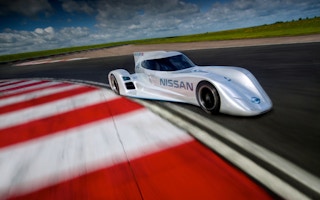Electric cars have yet to become mainstream but in the world of speedy cars and circuits, Nissan is set to change the game with its new ZEOD RC, the fastest electric racing car that clocks in 300 kilometres per hour.
To continue reading, subscribe to Eco‑Business.
There's something for everyone. We offer a range of subscription plans.
- Access our stories and receive our Insights Weekly newsletter with the free EB Member plan.
- Unlock unlimited access to our content and archive with EB Circle.
- Publish your content with EB Premium.
Unveiled at Le Mans, France, the site of the just concluded eponymous 24-hour endurance car race, Nissan announced that the ZEOD RC (Zero Emission On Demand Racing Car) prototype will still be developed and tested until it makes it racing debut at next year’s Le Mans. The plan is to have it compete as the “Garage 56” entry, a spot with experimental vehicles or those cars showing new technology.
Nissan ultimately intends to re-join the LM P1 class of the race, when it has determined the final makings of the ZEOD RC. Le Mans Prototype 1 (LM P1) is the main category representing the test bench for the most progressive technologies.
Currently, the sleek and stylish car runs with a purely electric system akin to Nissan’s Leaf Nismo RC. Both use the same lithium battery technology. However, the latter only runs at half the speed of the ZOED RC.
According to Andy Palmer, Nissan Motor Company Limited executive vice president and executive committee member, “The Nissan ZEOD RC is a natural progression that follows on from the development of the Nissan Leaf road car and the Leaf RC race car prototype. The technologies developed through the ZEOD RC programme will form part of future innovations for Nissan road cars.”
To fine-tune the ZEOD RC, Nissan runs a full factory international programme, the ZEOD RC programme, which culls input from Japan, Europe and the United States. The design team is headed by Ben Bowlby, formerly with the car company’s gas-powered DeltaWing programme and now the director of motorsport innovation.
Under the programme, multiple technologies will be used to develop the world’s fastest electric car. There is the Zero Emission on Demand variant where the racer can switch between electric and petrol power, which Palmer said is a future direction for road cars.
And there is also a pure electric power option and other new technologies still in development that are yet to be named.
Bowlby admits, however, that current battery technology cannot sustain a car to race Le Mans solely on electric energy. The designer explained it is due to the energy storage capacity. Still, he believes that the development of ZEOD RC is a significant move towards the direction of future race cars, the sport and road cars in general.
He said, “Developing a car like this provides an incredibly challenging test bed for what could be highly effective options for road cars of the future. Throughout the next twelve months, we will be testing multiple drive train options in an extensive test programme.”










